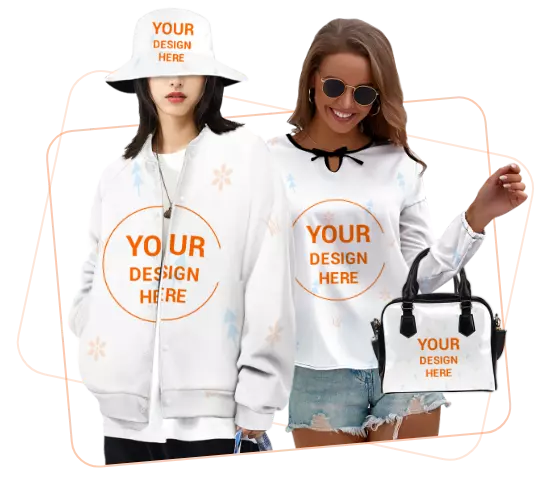
DIY Fashion Inspiration: Upcycling & Personalizing Old Clothes with New Prints
If you're craving something fresh in your wardrobe, that doesn't always mean shopping for new pieces. Sometimes, a different perspective and a touch of creativity are all it takes to make an old garment feel exciting again.
By choosing to upgrade your existing clothes, you save money and reduce waste. But more than that, each piece tells a story worth keeping—like a high school T-shirt you've worn for years or a hoodie from a memorable trip. These aren't just clothes; they're pieces of your timeline, and they deserve more than a quiet spot in the closet.
How to Tell Which Old Clothes are Good for Customizing
Not every old piece is ideal for reprinting or personalizing. Some fabrics don't hold prints well, and others may be too worn to wear comfortably again. But once you know what to look for, you'll realize many pieces still have potential.
- Cotton and cotton-blend fabrics are great for printing. They give crisp results and are easy to care for. Choosing the right fabric is the first step to making custom clothes.
- Solid or lighter colors work best as backgrounds for design—prints show up more clearly.
- Before starting, check the seams and overall shape. Avoid garments with deep stains or heavy distortion. A good foundation helps your final piece come out just right.
Creative Design Ideas to Try When Customizing Clothing
One thoughtful design or a short line of text can completely change how a piece feels. The placement, size, and meaning behind the print can all shift how you wear the item.
How Print Placement Changes the Whole Look
Designs don't need to sit front and center. A small chest logo feels subtle and personal. A bold print on the back or sleeve adds impact. Even tiny touches on the hemline or inside label can spark interest. These small surprises often bring the most delight.
Personal Icons That Mean Something to You
Your designs don't need to be complex. A pet's silhouette, a handwritten date, or an inside joke only your friends understand—these little symbols make a custom garment truly yours. It's about personal meaning, not perfection.
Not sure where to start? Look at what you haven't worn lately but still love. Think about why you kept it—maybe the fit, the memory, or the fabric feel.
- Add a paw print and your cat's name to a white T-shirt hem.
- Print a childhood quote in your handwriting across the back of a grey hoodie, creating a hoodie that's uniquely yours.
- Place a row of travel stamps along the side of your old track pants. You don't need advanced tools or art skills. Just use something meaningful to you. These touches don't need to be elaborate. They just need to feel honest and familiar.
Go Bold with Layout and Scale
If you prefer a standout piece, consider abstract artwork, oversized patterns, or off-balance placement. Layering, repeating, or rotating elements can add depth, even on a plain base. What starts as a basic tee can end up full of movement and personality.
How to Turn Old Clothes into Something Personal and Wearable
You don't need a workshop or special machines to start making custom clothes. A few simple steps and the right tools—digital or manual—can help you turn something old into something new. Here is how to go from an idea to a finished piece that feels personal.
Pick a Good Piece to Start
Look in your closet and find one piece you still like but don't wear much. Make sure the fabric is not stretched out or stained. Solid colors, especially light ones, are best for printing. If the shirt looks smooth and fits well, it is a good choice. A good base makes the final piece look better.
If your old shirt is too worn to wear, you can still keep its memory. Take the design or idea from that shirt and print it on a new one. A website like Inkedjoy has many styles and fabrics. You can buy just one shirt, so it's easy to make a fresh version to wear again.
Take a Clear Photo for Planning
Lay the clothing flat and take a photo in good light. This step helps you see your idea more clearly. You can upload the photo to a design app to check size and layout. A phone photo is fine if the light is bright and the angle is straight.

Upload Your Design to a POD Site
When your design is ready—like a drawing, a phrase, or a graphic—you can upload it to a print-on-demand website. These websites show how your design will look on real clothing. You can move things around and change sizes. You do not need any design software. Just upload your file.
Change the Placement and Size
Use the website tools to try different spots: center, back, sleeve, or bottom. Change the size and move things until they look right. Zoom in to check small parts, like thin lines or handwriting. If something feels off, keep fixing it until it looks good.
Check Everything Before You Buy
Zoom in and look at the design again. Is it in the center? Are the colors easy to see? Read your text again to catch mistakes. Even a small error can make the whole thing look bad. Take your time here—it helps avoid problems later.
Try a Simple Test at Home
If you're not sure how it will turn out, test it at home. You can buy iron-on paper or vinyl and use an iron to press the design on. This helps you see where to place the design and what it looks like. It's a low-cost weekend project that's easy to try.
4 Common DIY Mistakes to Avoid When Customizing Old Clothes
DIY is rewarding, but a few small mistakes can take away from the result. Be mindful of these common issues:
- Printing across seams or folds can lead to unclear designs.
- Ignoring the fabric's grain may reduce sharpness.
- Matching the design color too closely with the garment can make it fade visually.
- Placing prints too low may throw off overall proportions. Try to plan your design layout on paper first.
Check the shirt in good lighting before printing. Simple steps like this help you avoid regrets. A few easy tweaks can lift your piece from just okay to something you'll actually wear and enjoy.
Make It Yours: Wear Your Story, Not Just a Shirt
Customization isn't about perfection—it's about presence. Every piece you redesign is a reminder of your own creativity, your memories, and the clothes that stayed with you for a reason. Wearing something you shaped with your own hands might feel better than anything off the shelf.



